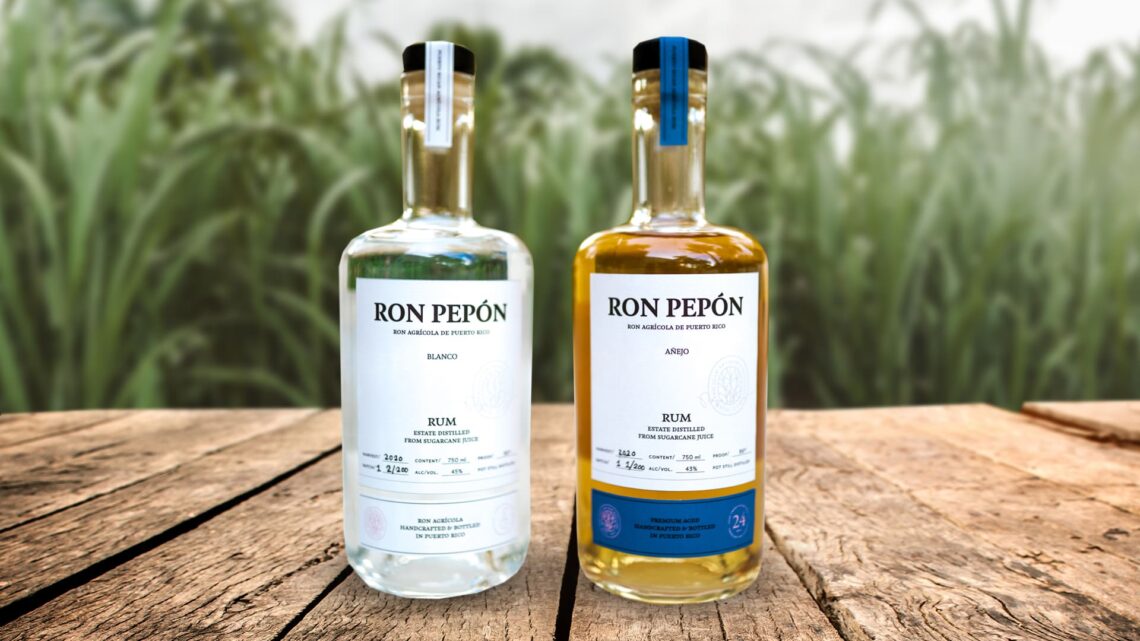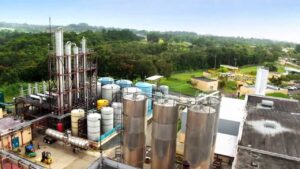Visitando San Juan Artisan Distillery

On July 19, 2022 a livestream of the program “Aqui se habla de ron” began on the ZAVVY platform, hosted by “The Rum Lab”, the livestream featured Fede J. Hernández, an entrepreneur specializing in sales and marketing, and Jaiker Soto, a chemical engineer with expertise in the distillation and fermentation process. They served as hosts of the livestream. The program aimed to interview its participant Jose R. Alvarez, the head distiller of the “San Juan Artisan Distillery,” who would talk about his experiences, background, and participation in the world of rum.
History and Involvement in the Rum World
Born in Puerto Rico, Jose R. Alvarez completed his studies as a civil engineer at the Mayagüez university. At that time, his father, a farmer, dedicated himself to researching rum and sugarcane. Became interested in the agricultural rum model during a trip to the French antilles. He began projects to bring these models to Puerto Rico. Projects that developed into what is today the “San Juan Artisan Distillery.” It is located in Vega Alta (Puerto Rico) and has sugarcane farms on its premises and in Vega Baja (Puerto Rico). They currently have 10 varieties of rum on the market and export some of their rums to the Virgin Islands and Florida.
How did his Studies in Civil Engineering Help Him in the Rum Industry?
Although civil engineering is focused more on the structure. The bases of the same helped him to integrate into the world of rum and with a more managerial approach developed from civil engineering. These studies have given him tools in the administrative and manufacturing aspects that have helped him to develop and integrate into the world of rum. With the supervision and guidance of his father and other consultants who have served as support.
How Much is Considered Separate from the Definition of “Agricultural Rum”?
The “Ron Pepon” products are defined by them as “agricultural rum” this term has its origin in France called in French “rhum agricole. But the term “rhum agricole” can not be used in their products so the term used ended up being “agricultural rum”. Because this rum is produced from their own canes and their own facilities. They are responsible for harvesting, milling, fermenting and distilling the cane for their products.
The white rum goes directly to its dilution and bottling, the aged rum is left in an aging process of 2 years in whiskey barrels, this is also defined as agricultural rum, there is also the rum “tres clavos” this is also a blend of cane juice rum, however it has a blend of Dominican rum that is imported from AFD, this has infusions of local fruits of the country.
What are the Advantages and disadvantages of processing from sugarcane?
Advantages:
One of the defined advantages was the possibility of importing to Puerto Rico something that has a lot of history, culture and nostalgia. And above all, many people can feel defined through the cane and its cultivation. This relationship with the cane can be seen more marked by the past generations of people who lived by the culture of the cane of Puerto Rico. So many people can get to feel inspired to see how agriculture again has relevance in Puerto Rico.
Another benefit that can be seen is through the environmental aspect. Because there are several ways to make rum. One of them is through the cane juice or molasses. However rum made with molasses, although it can greatly facilitate the production of rum. This method can be much more harmful to the environment so it is a method that must be done with great responsibility. Not to mention that it is a process that is more expensive. So in the end the most viable process is the cane juice because it is lighter and much easier to dispose of it to have uses as fertilizer being very positive for the fields resulting positive for the environment.
Disadvantages:
One of the disadvantages of working with sugarcane juice is the labor force. Which tends to be scarce in Puerto Rico. This company has three employees. Two of whom have been working for the San Juan Artisan Distillery for about 30 years. And are in charge of planting, harvesting and milling. This same labor problem comes with the fact that it is difficult to get young people interested in joining the agricultural area. So the company is considering employing workers from other countries through visa programs.
How Did They Manage to Develop These Varieties of Sugar Cane for Their Products?
The strains of cane used for their products were discovered in experimental stations in a similar way as it is done in the south of Puerto Rico. These have been canes that have been passed from generation to generation used for the sugar industry in Puerto Rico. So these have been canes that were made especially for the climate and land of Puerto Rico. The planting process began in its facilities in Vega Alta (Puerto Rico) with approximately 100 strains of cane. With the seeds generated from these strains it was possible to plant successfully in the farm of Vega Baja (Puerto Rico). However, this success was diminished by Hurricane “Maria” which passed through Puerto Rico affecting their farms and their crops. Currently they are in the process of restoring these same farms.
The varieties of cane and differences in color, physical form, sugar content and how these different canes react to the type of soil are really interesting. There is even a certain variety of cane used specifically for the manufacture of sugar. The ones used for the manufacture of their rum products are those that produce more juice. Because what is really necessary is less fiber and more juice.
The region of Puerto Rico has had a great growth in terms of farms and the agricultural movement in the south of the region. Being many of the promoters of these movements young people. Even despite the damage that could cause the hurricane “Maria”. At the time it is pleasing to see that these movements are still standing and growing.
San Juan Artisan Distillery Facility Tour
Fermentation Area:
The tour of the facilities where they manufacture their products began at this point. They showed the fermentation area first, where the fermentation tanks are located There are two large tanks, and between them is a smaller tank that processes the cane juices. The processed cane juice is then transferred to the fermenters as soon as possible, with the yeast already added. This helps to prevent the growth of unwanted agents or bacteria that can inhibit the production of healthy alcohol.
Although there is the option of transferring it directly to pasteurization. The company has the preference to transfer it directly to the fermenters so that the juice is more natural using wild yeasts. This same yeast is obtained from the juice of the cane that although it can have negative results if it is not handled correctly. If it is done in a hygienic and adequate way it can have good results obtaining better aroma and character. The company has made experiments using only this wild yeast. Obtaining good results but with a lower alcohol content. So it is preferred to use high quality yeasts, these make use of dry yeast that is previously hydrated with water or cane juice.
Fermentation Process:
The fermentation process lasts between 5 and 6 days, and they distill it in 2 days . After 12 hours, the temperature rises and the effervescence of carbon dioxide begins. Which generates a sweet smell that emanates from the facilities. At this point in the process, the sugarcane juice reaches a pleasant taste similar to the drink “Mabí” and as the process progresses. It goes from a sweet taste to a slightly more bitter one.
Once the fermentation process is complete. The alcohol content of the sugarcane juice reaches an alcohol content of between 7 and 8 percent. Although this can vary depending on several factors such as the amount of yeast, the amount of nutrients, or the hygiene of the pipes. If something is not properly cleaned, this percentage can be reduced. The hygiene of the tanks, pipes, and mills is of vital importance. And they are continuously cleaned using chemicals such as caustic soda and citric acid along with hot water.
Distillation Area:
After the fermentation process finishes, they distill the juice using their “Chalvignac” stills. The juice first passes through the largest still, the “Dirty Pot.” This first distillation extracts all of the alcohol from the juice, resulting in a “low wine.” The low wine is then transferred to an accumulation tank for its second distillation. The percentage of alcohol obtained from the second distillation varies depending on the still used, but it typically ranges from 7 to 9 percent. The accumulated product reaches a final average of between 7.4 and 7.5 percent. They also have an “Arnold Holstein” still made in Germany. This still has a column that purifies the finished product. They use this still for second distillations and to polish the final product.
Flavor Profile:
The flavor profile of the products varies depending on the still used for production, especially “Ron Pepon”, which has a distillate between two profiles. The distillate is divided, with 75% distilled in Chalvignac stills and 25% in Holstein stills. The distillate is aged separately. For white rum products, the unaged distillate is left in the larger storage tanks. From there, it is transferred to the blending tank, diluted, and finally transferred to bottling.
The product “Ron Pepon” has 42% alcohol, however, the alcohol content has increased to 45% due to the fact that there is a movement in search of products with a higher percentage of alcohol for various reasons. One of which may be the sensory experience that this type of product produces. Whether on the palate, the finish or the smell. The experience of alcohol is much greater with a higher percentage of alcohol. There are limits so different percentages are tested and tastings are done to reach the right degree of alcohol. Also the logistics of the facilities are decided and how many bottles will be produced. All this influences because the more percentage of alcohol represents less quantity of bottles produced by the level of alcohol concentration.
Aging Area:
The San Juan Artisan Distillery has a warehouse that holds between 600 and 700 barrels. And there are plans to expand the warehouse space to have a capacity of approximately 1500 barrels. These barrels were purchased from Brown Forman of the Jack Daniels distillery. These barrels are all new whisky barrels with at least one use to make their products. They have regulations and must be burnt inside, although an initial move was made to use whisky barrels. There are plans to use barrels for other types of alcohol products to get different results.
There are companies that have been using barrels for decades but they impart less and less flavour. Unlike the San Juan Artisan Distillery which uses young barrels that impart incredible flavours and unique characteristics to the production. “Ron Pepon”’ aged rum products have a two-year aging process and their “Tres Clavos” product line has a three-year aging process.
The white rum products do not undergo any type of treatment such as carbon filtering. The distillate passes directly from the still to the storage tanks. The blender dilutes the distillate, adds water, and then filters it through micron filters.
Mixing Room:
The processes carried out here are very artisanal. Here, products are peeled, cut, and weighed before being added to the formulas. This area has a bottling machine and a blending area.
The company creates the final formulas by mixing Tres Clavos product with a touch of sugar and the fruit extracts it receives.
Sensory Description of Their Products
To end the programme Jose R. Alvarez tasted his product ‘Ron Pepon’ and gave a sensory description of it. This has a light tone of bright golden colour. This colour can vary depending on the barrel and the ageing time. The smell of it has great complexity with notes of toasted wood, cane juice, dried fruits, vanilla and cinnamon with certain bourbon characteristics. The taste is an explosion of complex flavours such as cane, whisky and caramelised notes of brown sugar.
The products of this company do not contain artificial colouring. The colours that the products have come directly from the barrel and do not contain additives. The “Tres Clavos” rums do add about one ounce per bottle. Which in comparison to the local cane rum industry is very little as they add one cup of sugar. The company prefers to keep the sugar low to make it healthier and give it more versatility for the cocktails.
The fruits used for the products have no fermentation process as the alcohol controls. And preserves the fruit and prevents oxidation of the fruit. Rum bottles have a one-year shelf life. But this is due to marketing and political issues, as time can enhance the flavour by maceration of the fruits.
Featured image: San Juan Artisan Distillers













